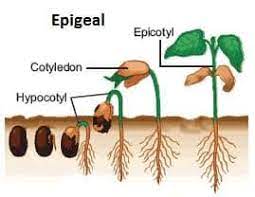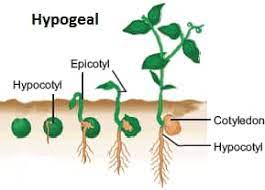EPIGEAL AND HPOGEAL GERMINATION
Seeds when sown in moist soil, germinate under favorable temperature and sufficient aeration. However, sometimes seeds don’t germinate due to some reasons called seed dormancy.
The radicle is the first organ to emerge from the seed in nearly all cases. The radicle is soon followed by the plumule of young shoot.
Hypogeal germination indicating that the germination of a plant takes place “below the ground”. The opposite of hypogeal is epigeal (“above-ground germination”).
What is Epigeal germination?
- In many dicotyledonous plants such as groundnut, beans etc., the cotyledons emerge from the soil and function as first leave. Then it is brought to soil surface without damage because they are present inside the thick cotyledons.
- Here the cotyledons are brought out of the soil by curved elongation of hypocotyl. This type of germination where cotyledons emerge out of the soil is called epigeal germination.
- Examples: Beans, onions, papaya, castor, gourds etc.

What is Hypogeal germination?
- Hypogeal germination indicating that the germination of a plant takes place “below the ground”. The epicotyl (part of the stem above the cotyledon) grows, while the hypocotyl (part of the stem below the cotyledon) remains the same in length. In this way, the epicotyl pushes the plumule above the ground.
- In monocotyledonous plants, the cotyledon remains in the soil. The plumule grow or is pushed upward by the elongation of epicotyl.
- This type of germination is called hypogeal germination since the cotyledon is below or inside the soil.
- Because the cotyledon stays below the ground, it is much less vulnerable to night-frost or grazing.
- Plants that show hypogeal germination need relatively little in the way of external nutrients to grow, therefore they are more frequent on nutrient-poor soils. The plants also need less sunlight, so they can be found more often in the middle of forests, where there is much competition to reach the sunlight.
- Dicotyledons also exhibit hypogeal germination when sown deep.
- Examples: coconut, gram, maize, custard apple, mango, pea, lotus etc.

Note: It is possible that within the same genus one species shows hypogeal germination while another species shows epigeal germination. Some genera in which this happens are:
- Phaseolus: the runner bean (Phaseolus coccineus) shows hypogeal germination, whereas the common bean (Phaseolus vulgaris) shows epigeal germination.
- Lilium.
- Araucaria: species in the section Araucaria show hypogeal germination, whereas species in the section Eutacta show epigeal germination.
Read also…
SEED MULTIPLICATION & SEED REPLACEMENT RATIO
SEED CLASSES- TYPE AND FEATURES
TYPES OF SEED- STRUCTURE & FEATURES
SEED DISPERSAL- TYPES AND IMPORTANCE
MCQ ON SEED TECHNOLOGY PART-1